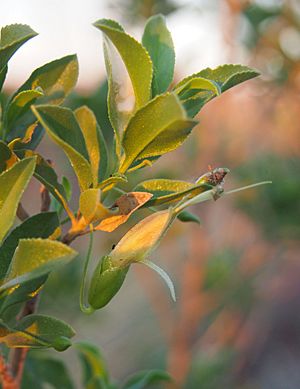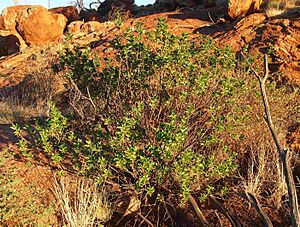Serrate-leaved eremophila facts for kids
Quick facts for kids Serrate-leaved eremophila |
|
|---|---|
 |
|
| Scientific classification | |
| Genus: |
Eremophila (plant)
|
| Species: |
serrulata
|
| Synonyms | |
|
|
The Eremophila serrulata, also known as the serrate-leaved eremophila or green fuchsia bush, is a type of flowering plant. It belongs to the figwort family, called Scrophulariaceae. This plant is only found in Australia, meaning it is endemic there. It grows as an upright or spreading shrub. Its leaves are a bit sticky and have small, saw-like edges. The flowers of this plant can be green, yellowish-green, or yellowish-brown.
Contents
What Does the Serrate-Leaved Eremophila Look Like?
The serrate-leaved eremophila is a shrub that typically grows to be about 0.8 to 2.5 meters (2.6 to 8.2 feet) tall and wide. Its leaves grow one after another along the branches. They can be shaped like a spear, an egg, or almost perfectly round. Each leaf has a small stem, about 2 to 12 millimeters (0.08 to 0.47 inches) long.
The main part of the leaf is usually 11 to 51 millimeters (0.43 to 2.01 inches) long and 6 to 22 millimeters (0.24 to 0.87 inches) wide. These leaves often have many tiny, saw-like teeth along their edges. Sometimes, they have a few hairs, but these are often hidden by a sticky substance called resin.
Flowers and Fruit
The flowers of the serrate-leaved eremophila grow one by one where the leaves meet the stem. Each flower sits on a slightly hairy, S-shaped stalk that is about 10 to 25 millimeters (0.39 to 0.98 inches) long. There are five overlapping, smooth, spear-shaped or egg-shaped sepals, which are like small leaves that protect the bud. These sepals are mostly 10 to 15 millimeters (0.39 to 0.59 inches) long.
The petals of the flower are 20 to 30 millimeters (0.79 to 1.18 inches) long and are joined together at their base to form a tube. This petal tube is green, yellowish-green, or yellowish-brown. Both the inside and outside of the tube are covered with tiny, sticky hairs called glandular hairs. The four stamens, which produce pollen, stick out beyond the end of the petal tube. This plant flowers all year round, but mostly from April to October. After flowering, it produces fruits that are oval or almost round, about 5 to 7 millimeters (0.20 to 0.28 inches) long, and have a smooth, pale grey covering.
How Was This Plant Named?
The serrate-leaved eremophila was first officially described in 1847. This description was made by a botanist named Alphonse Pyramus de Candolle. He used notes from another botanist, Allan Cunningham, who had described it earlier but not published it. They first named it Stenochilus serrulatus. This description was published in a book called Prodromus Systematis Naturalis Regni Vegetabilis.
Later, in 1917, George Claridge Druce changed the name to Eremophila serrulata. He published this change in a report called The Botanical Exchange Club and Society of the British Isles Report for 1916, Supplement 2. The second part of the plant's scientific name, serrulata, comes from a Latin word. It means "toothed like a saw," referring to the finely serrated or saw-like edges of the plant's leaves.
Where Does the Serrate-Leaved Eremophila Grow?
The green fuchsia bush is a common plant found in many parts of Australia. You can find it widely spread across Western Australia, South Australia, the Northern Territory, and New South Wales.
In Western Australia, it grows between the towns of Warburton and Shark Bay. In South Australia, it is found in several different plant regions, including the North-Western, Lake Eyre, Nullarbor, and Flinders Ranges areas. In the Northern Territory, it only grows in the far southwest. In New South Wales, it is found in the northwest plains, southwest plains, and northern far-west plains. This plant often grows in thin, rocky soils on hillsides. It is frequently found in areas with mulga or mallee woodlands.
Is the Serrate-Leaved Eremophila Protected?
The Western Australian Government's Department of Parks and Wildlife has officially classified Eremophila serrulata as "not threatened." This means that the plant is not currently at risk of disappearing from the wild.
How Can We Use This Plant in Gardens?
Even though its flowers are not super showy, the serrate-leaved eremophila is a very tough and long-lasting shrub. It's great for attracting birds that feed on nectar. This plant can grow well in difficult places, like heavy clay soils, where many other plants might struggle.
You can grow new plants from cuttings taken from the parent plant. If it's grown on its own roots, it might produce new shoots from its base, which are called suckers. If you don't want these suckers, you can also grow it by grafting it onto a Myoporum rootstock. This plant can grow in most types of soil, whether in full sun or partial shade. It is also very good at handling dry conditions (drought tolerant) and cold temperatures (frost tolerant).


